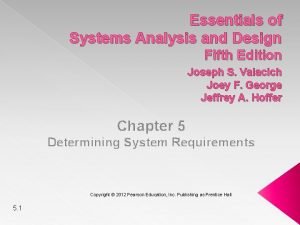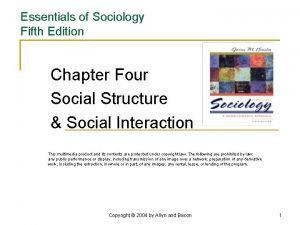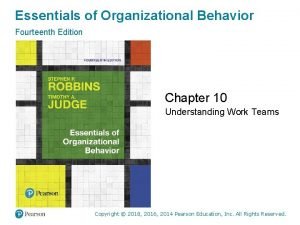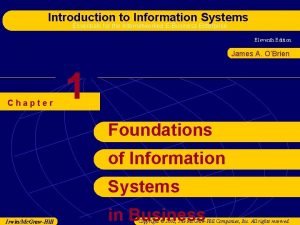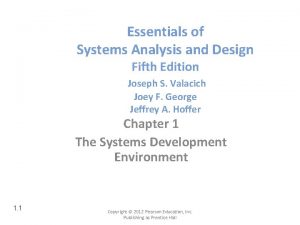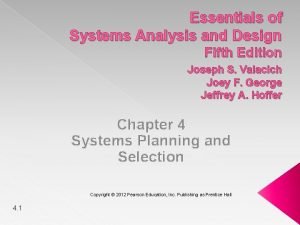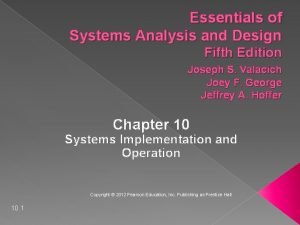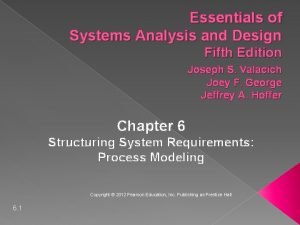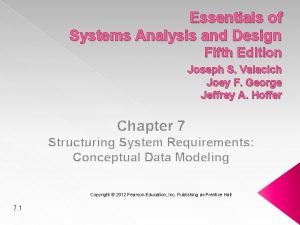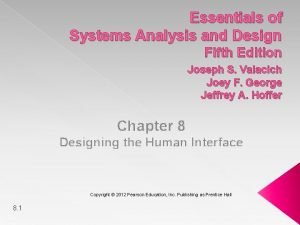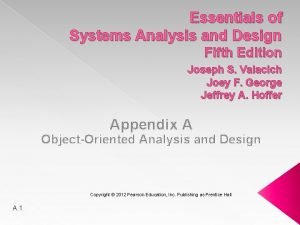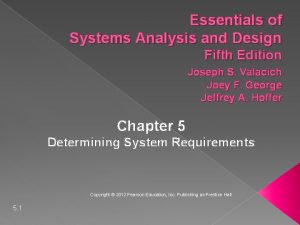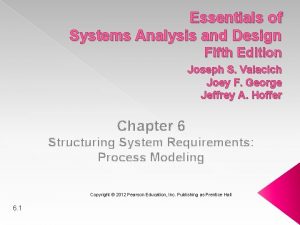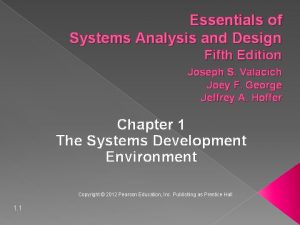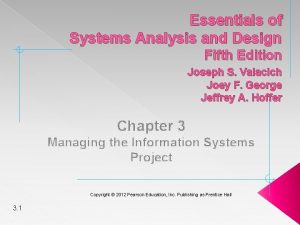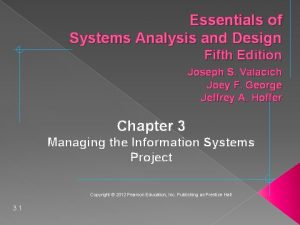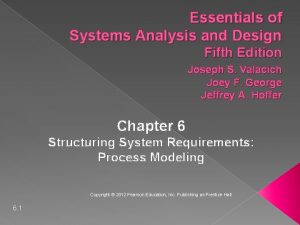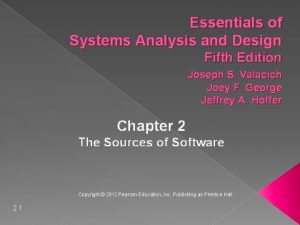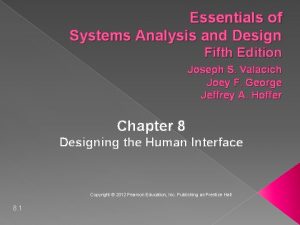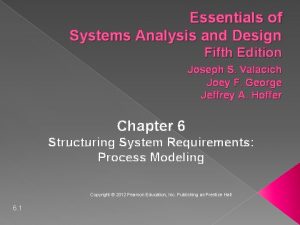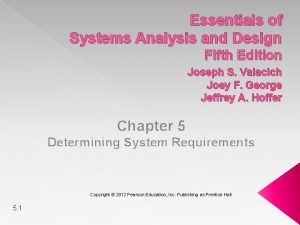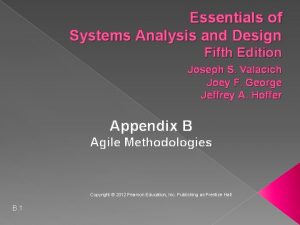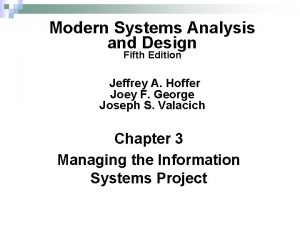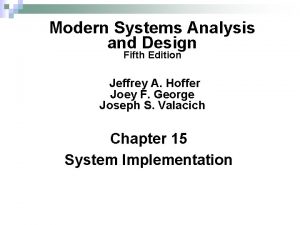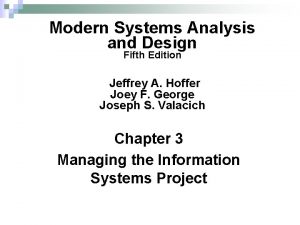Essentials of Systems Analysis and Design Fifth Edition



























- Slides: 27

Essentials of Systems Analysis and Design Fifth Edition Joseph S. Valacich Joey F. George Jeffrey A. Hoffer Chapter 9 Designing Databases Copyright © 2012 Pearson Education, Inc. Publishing as Prentice Hall 9. 1

Learning Objectives ü ü ü ü Understand role of logical and physical database design in the analysis and design of an information system Transforming an ERD to an equivalent set of well-structured relations Merge normalized relations from separate user views into a consolidated set of well-structured relations Explain choices of storage formats for database tables Transforming well-structured relations into efficient database tables Understand different types of file organizations to store database files Discuss indexes and their purpose 9. 2 Copyright © 2012 Pearson Education, Inc. Publishing as Prentice Hall

Learning Objectives ü Define the following database terms: ü ü ü Relation Primary key Functional dependency Foreign key Referential integrity Field Data type Null value Denormalization File organization Index Secondary key 9. 2 Copyright © 2012 Pearson Education, Inc. Publishing as Prentice Hall

Deliverables and Outcomes Logical database design must account for every data element, system input or output Normalized relations are the primary deliverable Physical database design results in converting relations into files 9. 4 Copyright © 2012 Pearson Education, Inc. Publishing as Prentice Hall

Process of Database Design Logical Design � › › Based upon the conceptual data model Four key steps: 1. Develop a logical data model for each known user interface for the application using normalization principles 2. Combine normalized data requirements from all user interfaces into one consolidated logical database model 3. Translate the conceptual E-R data model for the application into normalized data requirements 4. Compare the consolidated logical database design with the translated E-R model and produce one final logical database model for the application 9. 5 Copyright © 2012 Pearson Education, Inc. Publishing as Prentice Hall

Process of Database Design Physical Design � › › Based upon results of logical database design Key decisions: 1. Choosing storage format for each attribute from the logical database model 2. Grouping attributes from the logical database model into physical records 3. Arranging related records in secondary memory (hard disks and magnetic tapes) so that records can be stored, retrieved, and updated rapidly 4. Selecting media and structures for storing data to make access more efficient 9. 6 Copyright © 2012 Pearson Education, Inc. Publishing as Prentice Hall

Relational Database Model � � Data represented as a set of related tables or relations Relation › A named, two-dimensional table of data. Each relation consists of a set of named columns and an arbitrary number of unnamed rows › Properties �Entries in cells are simple �Entries in columns are from the same set of values �Each row is unique �The sequence of columns can be interchanged without changing the meaning or use of the relation �The rows may be interchanged or stored in any sequence 9. 7 Copyright © 2012 Pearson Education, Inc. Publishing as Prentice Hall

Relational Database Model Well-Structured Relation › A relation that contains a minimum amount of redundancy and allows users to insert, modify, and delete the rows without errors or inconsistencies 9. 8 Copyright © 2012 Pearson Education, Inc. Publishing as Prentice Hall

Normalization The process of converting complex data structures into simple, stable data structures � Eliminates redundancy � 9. 9 Copyright © 2012 Pearson Education, Inc. Publishing as Prentice Hall

Normalization Second Normal Form (2 NF) › Each nonprimary key attribute is identified by the whole key (called full functional dependency) Third Normal Form (3 NF) › Nonprimary key attributes do not depend on each other (called transitive dependencies) The result of normalization is that every nonprimary key attribute depends upon the whole primary key. 9. 10 Copyright © 2012 Pearson Education, Inc. Publishing as Prentice Hall

Functional Dependencies and Primary Keys Functional Dependency › A particular relationship between two attributes. For a given relation, attribute B is functionally dependent on attribute A if, for every valid value of A, that value of A uniquely determines the value of B. › Instances (or sample data) in a relation do not prove the existence of a functional dependency › Knowledge of problem domain is the most reliable method for identifying functional dependency 9. 11 Copyright © 2012 Pearson Education, Inc. Publishing as Prentice Hall

Functional Dependencies and Primary Keys Second Normal Form (2 NF) › A relation is in second normal form (2 NF) if any of the following conditions apply: 1. The primary key consists of only one attribute 2. No nonprimary key attributes exist in the relation 3. Every nonprimary key attribute is functionally dependent on the full set of primary key attributes 9. 12 Copyright © 2012 Pearson Education, Inc. Publishing as Prentice Hall

Functional Dependencies and Primary Keys Conversion to second normal form (2 NF) › To convert a relation into 2 NF, decompose the relation into new relations using the attributes, called determinates, that determine other attributes › The determinates become the primary key of the new relation 9. 13 Copyright © 2012 Pearson Education, Inc. Publishing as Prentice Hall

Functional Dependencies and Primary Keys Third Normal Form (3 NF) › A relation is in third normal form (3 NF) if it is in second normal form (2 NF) and there are no functional (transitive) dependencies between two (or more) nonprimary key attributes › To convert a relation into 2 NF, decompose the relation into two relations using the two determinants 9. 14 Copyright © 2012 Pearson Education, Inc. Publishing as Prentice Hall

9. 15 Copyright © 2012 Pearson Education, Inc. Publishing as Prentice Hall

Functional Dependencies and Primary Keys Foreign Key › An attribute that appears as a nonprimary key attribute in one relation and as a primary key attribute (or part of a primary key) in another relation Referential Integrity › An integrity constraint specifying that the value (or existence) of an attribute in one relation depends on the value (or existence) of the same attribute in another relation 9. 16 Copyright © 2012 Pearson Education, Inc. Publishing as Prentice Hall

Transforming E-R Diagrams into Relations It is useful to transform the conceptual data model into a set of normalized relations Steps: 1. 2. 3. 4. Represent entities Represent relationships Normalize the relations Merge the relations 9. 17 Copyright © 2012 Pearson Education, Inc. Publishing as Prentice Hall

Transforming E-R Diagrams into Relations Represent Entities 1. › › › Each regular entity is transformed into a relation The identifier of the entity type becomes the primary key of the corresponding relation The primary key must satisfy the following two conditions a. The value of the key must uniquely identify every row in the relation b. The key should be non-redundant 9. 18 Copyright © 2012 Pearson Education, Inc. Publishing as Prentice Hall

9. 19 Copyright © 2012 Pearson Education, Inc. Publishing as Prentice Hall

Transforming E-R Diagrams into Relations Represent Relationships 2. › Binary 1: N Relationships Add the primary key attribute (or attributes) of the entity on the one side of the relationship as a foreign key in the relation that is on the right side The one side migrates to the many side 9. 20 Copyright © 2012 Pearson Education, Inc. Publishing as Prentice Hall

9. 21 Copyright © 2012 Pearson Education, Inc. Publishing as Prentice Hall

Transforming E-R Diagrams into Relations Represent Relationships (continued) 2. › Binary or Unary 1: 1 Three possible options: a. Add the primary key of A as a foreign key of B b. Add the primary key of B as a foreign key of A c. Both › Binary and higher M: N relationships Create another relation and include primary keys of all relations as primary key of new relation 9. 22 Copyright © 2012 Pearson Education, Inc. Publishing as Prentice Hall

9. 23 Copyright © 2012 Pearson Education, Inc. Publishing as Prentice Hall

Transforming E-R Diagrams into Relations › Unary 1: N Relationships Relationship between instances of a single entity type Utilize a recursive foreign key A foreign key in a relation that references the primary key values of that same relation › Unary M: N Relationships Create a separate relation Primary key of new relation is a composite of two attributes that both take their values from the same primary key 9. 24 Copyright © 2012 Pearson Education, Inc. Publishing as Prentice Hall

9. 25 Copyright © 2012 Pearson Education, Inc. Publishing as Prentice Hall

9. 26 Copyright © 2012 Pearson Education, Inc. Publishing as Prentice Hall

Transforming E-R Diagrams into Relations Merging Relations (View Integration) 3. › › Purpose is to remove redundant relations View Integration Problems • Synonyms • Homonyms • § § Two different names used for the same attribute When merging, get agreement from users on a single, standard name A single attribute name that is used for two or more different attributes Resolved by creating a new name Dependencies between nonkeys § § Dependencies may be created as a result of view integration In order to resolve, the new relation must be normalized 9. 27 Copyright © 2012 Pearson Education, Inc. Publishing as Prentice Hall
 Essentials of systems analysis and design
Essentials of systems analysis and design Modern systems analysis and design
Modern systems analysis and design Modern systems analysis and design 7th edition
Modern systems analysis and design 7th edition Principles of marketing fifth european edition
Principles of marketing fifth european edition Lazarus theory
Lazarus theory Fundamentals of corporate finance fifth edition
Fundamentals of corporate finance fifth edition Democritus atomic model diagram
Democritus atomic model diagram Molecular biology of the cell
Molecular biology of the cell Molecular biology
Molecular biology Human anatomy fifth edition
Human anatomy fifth edition Human anatomy fifth edition
Human anatomy fifth edition Network security essentials 5th edition pdf
Network security essentials 5th edition pdf Business essentials 12th edition chapter 1
Business essentials 12th edition chapter 1 Essentials of investments 11th edition
Essentials of investments 11th edition Business essentials 12th edition answer key
Business essentials 12th edition answer key Essentials of sociology 5th edition
Essentials of sociology 5th edition Firefighter essentials 7th edition
Firefighter essentials 7th edition Business essentials 12th edition
Business essentials 12th edition The time/space collaboration and social tool matrix
The time/space collaboration and social tool matrix Essentials of organizational behavior 14th edition
Essentials of organizational behavior 14th edition At a bulk transport incident firefighters must
At a bulk transport incident firefighters must Cryptographic systems are generically classified by
Cryptographic systems are generically classified by Criminal justice the essentials 5th edition
Criminal justice the essentials 5th edition System analysis and design by kendall
System analysis and design by kendall Essentials of information systems
Essentials of information systems Information model specification in iot
Information model specification in iot Visual communication and graphic design essentials
Visual communication and graphic design essentials Tis now the very witching time of night soliloquy
Tis now the very witching time of night soliloquy
